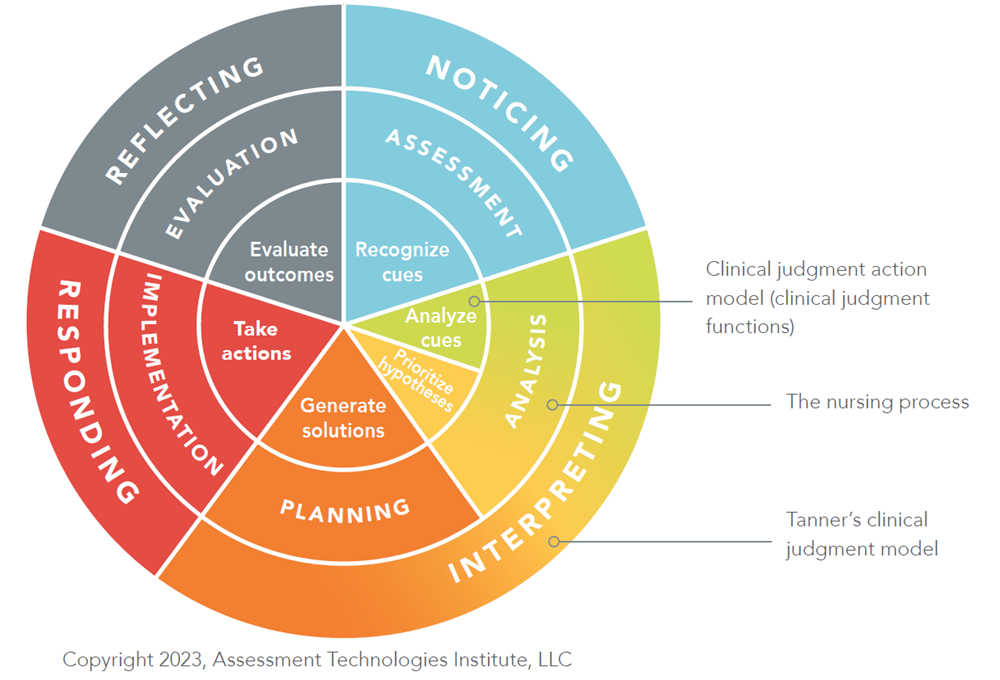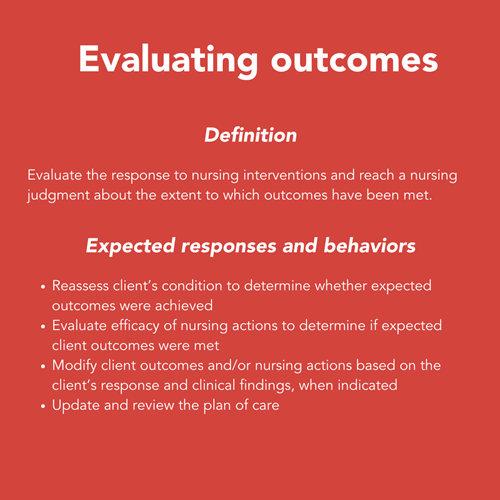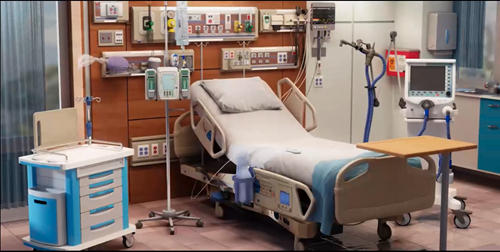Teaching students the sixth clinical judgment function, to evaluate outcomes
Evaluating outcomes is an essential component of nursing care, and it is the sixth function identified by the National Council of State Boards of Nursing (NCSBN) in its model for clinical judgment.
The evaluation of outcomes requires the nurse to assess the effectiveness of nursing interventions and determine their impact on client outcomes. By evaluating outcomes, nurses can identify the effects of their actions and make informed decisions about the client’s care. This cognitive function is essential for monitoring patient progress, detecting any complications, and intervening promptly if necessary.
Teaching nursing students how to evaluate outcomes requires active learning
Teaching nursing students how to evaluate outcomes involves a combination of theoretical knowledge and practical application. Research1 suggests that incorporating active learning strategies, such as case studies, simulations, and reflective exercises, can enhance students' understanding of, and their ability to, evaluate outcomes. These methods allow students to engage in real-life scenarios and reflect on their decisions and actions.
When teaching nursing students to evaluate outcomes, a combination of one-on-one strategies and interactive digital learning solutions can be effective. The Engage™️ Series, a virtual interactive education resource from ATI Nursing Education, can play a pivotal role in helping students develop their ability to evaluate outcomes and exercise clinical judgment overall.
Learn more about interactive digital learning
Using Engage, students participate in realistic client scenarios, analyze the impact of their interventions, and assess outcomes. This interactive platform provides immediate feedback, allowing students to reflect on their decisions and improve their evaluation skills.
Interactive learning helps students develop knowledge, confidence, and NCLEX readiness
The Engage Series consists of online learning solutions that incorporate knowledge acquisition, retention of knowledge, remediation content, and review, said ATI Strategic Nursing Advisor Beth Cusatis Phillips, PhD, RN, CNE, CHSE.
 “The content in Engage is structured using the six clinical judgment functions from the NCSBN, and it can solidify students’ learning of these essential cognitive skills,” Dr. Phillips said. “Engage will better prepare students for NGN items, and it will set them up for success as nurses.”
“The content in Engage is structured using the six clinical judgment functions from the NCSBN, and it can solidify students’ learning of these essential cognitive skills,” Dr. Phillips said. “Engage will better prepare students for NGN items, and it will set them up for success as nurses.”
The Engage Series incorporates:
- evidence-based information that is essential for nursing practice — the content new nurses most need to know
- active learning via interactive activities, quizzing within each module, and summative review questions at the end
- videos, virtual applications, animations, 3D diagrams, and games that bring learning to life
- branching logic within simulations, to instill deeper learning
- development of documentation skills using embedded features of EHR Tutor
- podcasts that extend learning using real-life examples.
During a recent ATI webinar, Dr. Phillips focused on the clinical judgment function of evaluating outcomes and highlighted the ways Engage™️ Adult Medical-Surgical can help deliver this learning. Access this webinar recording here.
The webinar was the sixth in a series that demonstrates how Engage solutions help students learn to make nursing decisions using clinical judgment. Find articles about each segment of the video series at the links below:
Article 1: Teach nursing students how to recognize cues using the Engage Series
Article 2: Teach nursing students to analyze cues using interactive tools
Article 3: Teaching nursing students how to prioritize hypotheses using interactive learning tools
Article 4: Teaching nursing students to generate solutions
Article 5: Teaching nursing the fifth clinical judgment function, take action.

The ATI Guide for Clinical Judgment, shown above, visually depicts the interrelationship among the Clinical Judgment Action Model, the Nursing Process, and Tanner’s Clinical Judgment Model. The evaluation of outcomes occurs in the evaluation phase of the nursing process and the reflecting phase of Tanner's Clinical Judgment Model.
Expected responses and behaviors when evaluating outcomes
As with the other clinical judgment functions, a definition and a list of expected responses and behaviors, shown below, has been developed for the function of evaluating outcomes.

In her webinar presentation, Dr. Phillips highlighted several ways that students learn and practice the sixth clinical judgment function by progressing through the five critical care modules in Engage Adult Medical-Surgical. Throughout the content, students are prompted to generate the expected responses and behaviors.
“We developed five critical care modules because so many new graduates are going right into critical care after passing NCLEX,” Dr. Phillips said. “Some may get exposure to critical care during school, but many do not. These modules help prepare them for the equipment, conditions, and acuity of critical care units.”
In the Engage Adult Medical-Surgical critical care modules, students learn the necessity for rapid, concise assessment and the importance of observing small changes in their clients, she said.
The critical care nursing content is presented in the following modules:
- Introduction to critical care and emergency nursing
- Critical alterations in gas exchange
- Critical alterations in perfusion
- Critical neurologic dysfunction
- Critical endocrine dysfunction.
Through these modules, students learn concepts that include:
- assessment in critical care situations
- developing competence in critical care practice
- interprofessional team care in critical care settings
- participation in critical care codes and emergencies
- family presence during resuscitation
- assessment in the emergency department
- assessment in a disaster.
Engage creates understanding of real-life clinical nursing situations
Through the content and experiences delivered in Engage Adult Medical-Surgical, students “will realize the importance of the team in a distinct way,” Dr. Phillips said. “In critical care, you must rely on each other when a patient's condition deteriorates. Students will experience a code and understand the various responsibilities nurses have during these events.
“Using the clinical judgment functions, students will learn the incredible importance of their recognition of even the smallest change,” she continued. “If a client who was alert and oriented is now irritable, it could be an early sign of cerebral edema, hypoxia, or a number of other things.”
When analyzing cues in a critical care situation, time takes on heightened importance. “Time may mean the difference between life and death,” Dr. Phillips said. “Students will learn how important assessment skills are to the client outcome — particularly understanding expected and unexpected findings.”
Through the activities in Engage, students gain understanding, and are able to practice, the ABCs of nursing prioritization.
“Nurses and the rest of the critical care team must prioritize airway, breathing, and circulation so they can keep their clients alive and hopefully help them to recover,” Dr. Phillips said, referring to simulation activities in the critical care unit.
Interactive learning helps nursing students understand the demands of critical care
Also in the critical care modules, nursing students learn that they must pay attention to multiple signals and situations.
“They may be auscultating breath sounds on a client with a flail chest and must pay attention to facial grimacing, irregular respirations, and chest symmetry all at the same time,” Dr. Phillips said. “It helps to paint that picture of what's happening and what needs to happen next.”
When generating solutions, students learn to set goals, include the client’s family, and to pay attention to details while developing a nursing plan, she said.
“In the take action phase, timing is critical. We often don't have time to debate what should be done next,” Dr. Phillips said. “We have to make educated decisions.”
Using visual applications in Engage, students practice making decisions. “We even have a clock embedded into our simulation. This steers students to consider what to do when, and to be very cognizant of time,” Dr. Phillips said.
To provide practice in evaluating outcomes, the activities in Engage help students recognize that their responsibilities continue after making decisions about care.
“We evaluate frequently and may make small changes in order to stabilize a client,” Dr. Phillips explained. “In the critical care modules, students are prompted to consider actions individualized to each simulated client’s care.”

Engage Adult Medical-Surgical displays realistic scenes such as the critical care room shown above.
“You can see the monitor, the ventilator, the ambu bag and the crash cart,” Dr. Phillips said. “Students will learn about this equipment and how and when to use it. They will learn about telemetry and analyzing EKG rhythm strips as well.”
Throughout Engage Adult Medical-Surgical, students are prompted to make important connections that carry over into nursing practice. Dr. Phillips mentioned a few examples: connections between immobility and skin integrity, hypoxemia and altered level of consciousness, and diabetes and sensory deficits.
“Students often miss these linkages because they are so focused on the specifics of the disease or disorder,” she noted. “However, they need to be able to broaden their scope to see these important connections, too. Engage makes that much easier for them.”
Engage Adult Medical-Surgical, as well as the other solutions in the Engage Series, incorporate 3D images and animations. “This makes learning more fun — and for visual learners, it makes the information stick,” Dr. Phillips said.
“Engage Adult Medical-Surgical — along with the other solutions in the Engage Series — will help you ensure that your students are ready for the realities of practice, have solid clinical judgment skills, and make strong clinical decisions,” she said.
As of winter 2024, the Engage Series consists of Engage Adult Medical-Surgical, Engage™️ Community & Public Health, and Engage™️ Mental Health. ATI Nursing Education will introduce additional content areas in fall 2024. For information, contact your ATI Nursing Education representative.
Reference
1. Phillips, B.C., Johnson, J., Khalid, N., Zapparrata, N., Albright, G. (2023). Benefits of an online interactive educational program over traditional textbooks. Nurse Educator. DOI: 10.1097/NNE.0000000000001398

